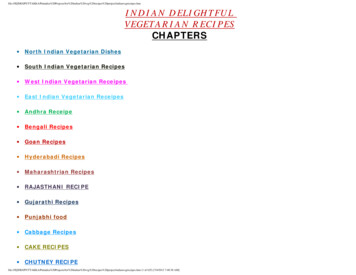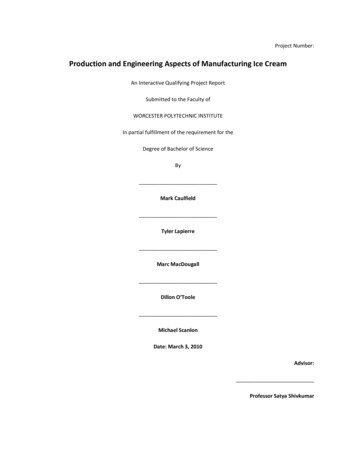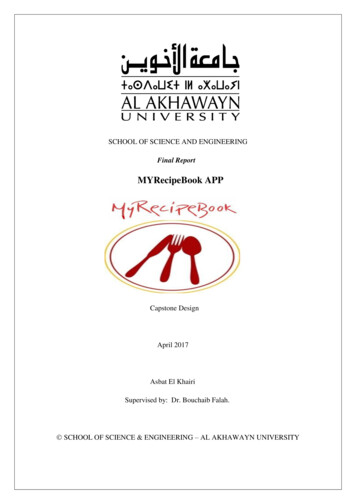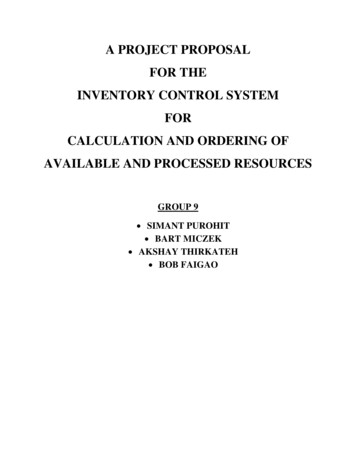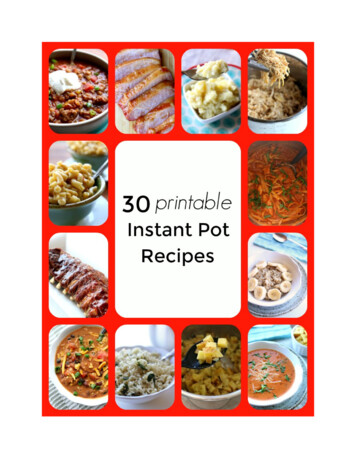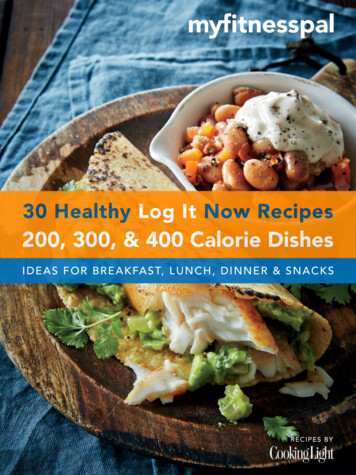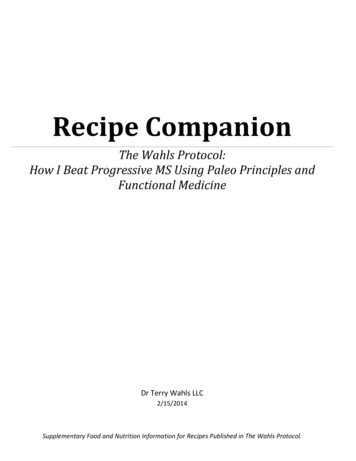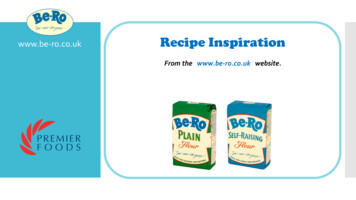
Transcription
www.be-ro.co.ukRecipe InspirationFrom the www.be-ro.co.uk website.
www.be-ro.co.ukBe-Ro Recipe BookSince 1923 and now in its 41st Edition !Containing over 125 recipes, and helpful hints and tipsOrder your copy on-line at www.be-ro.co.uk
Baking BasicsHere you'll find all the information you need to becoming a bakingexpert. From choosing your ingredients through to testing yourfinished cake, all the help you need is right here.- BasicsRecipe Remedies- Remedies- RecipesIf your sponge is too soggy or your pastry is too crumbly, we havethe solution right here. Our helpful advice will give you all theanswers you need to solve those tricky baking problems.Recipe InspirationHere you'll find great ideas for all kinds of recipes, from quick andeasy meals through to recipes for the baking expert.
Welcome to Baking BasicsThese are core recipes and skills and other information that you’ll needfor preparing many of the other recipes in this collection.- Basics- Remedies- RecipesBut more than that these basics will provide you with the fundamentalknowledge that will serve you well for all your baking needs in future ! A Word about our RecipesA Word on IngredientsBaking with Be-RoBatch BakingCake BasicsCelebration Fruit CakesChoux PastryCooking in your MicrowaveCreaming MethodFlaky PastryFlan BasicsHome FreezingLining a Pudding Basin Melting MethodMetric / Imperial MeasurementsOther Useful MeasuresOven ManagementPastry BasicsPie BasicsRolling Brandy SnapsRough Puff PastryRubbed in MethodShortcrust PastrySteamed PuddingsSuet PastryWhisking Method
A Word about our Recipes We have categorised our recipes in order to help you judge the level ofexpertise required for each one.- Basics- Remedies- RecipesLook for the coloured “A-B-C” indicator on the recipe card AEasy BakingBMore Involved BakingCSkilful Baking
A Word on IngredientsSUGARCaster sugar dissolves easily and is most suitable for cake making, being finerit is more easily creamed than granulated sugar, which is better used inrubbed-in cakes. Demerara and other brown sugars are often used in rich fruitcakes and gingerbreads to improve the flavour and colour. Icing sugar shouldbe sieved if at all lumpy. Golden syrup, treacle or honey often replace some orall of the sugar in a recipe, giving a rich flavour and colour.EGGSEggs are better used at room temperature, rather than cold from the fridge,but this is not essential. Eggs add richness to the recipe. Break eggs separatelyinto a cup to ensure freshness. Medium (standard eggs) are used in all Be-Rorecipes, unless otherwise stated.- Basics- Remedies- RecipesLIQUIDS Milk adds richness to a mixture and gives a closer, heavier texture. Water givesa lighter, short texture. Very cold water is necessary for certain pastries.FATSUse the type stated in the recipe. Butter is used for its flavour and keepingqualities but margarine is better for giving volume in creamed cakes. Hard orblock margarine is most suitable for baking. Soft margarine is recommendedfor all-in-one recipes.
Baking with Be-RoBe-Ro Flour has been producing consistently good results for over a century. It is- Basics- Remedies- Recipeslight, free-flowing flour without lumps, so there is no need to sieve. The lighttexture also means easier mixing and the best possible rise to cakes and scones.In the recipes, metric quantities are given first with imperial in brackets. You willget good results using either metric or imperial units provided you use the sameunit throughout; it is not advisable to mix the two as the quantities differ slightly.Storage of Be-Ro FlourYour flour will keep at its best if stored in its bag in a cool dry place. If the kitchenshould get steamy or damp, keep the bag in a storage container with a lid. Do notadd new flour to old. Both Be-Ro Plain and Be-Ro Self Raising flour bags carry aBest Before date. Be-Ro Flour will be at its best before this date.
Batch Baking1/2Batch baking is an economical way of having baked goods for the family which will last days.- Basics- Remedies- RecipesOwning a freezer makes batch baking an even more viable method of cooking as a variety of baked itemscan be frozen ahead of time and used as required. This is beneficial if you have less time to spend on mealpreparation as well as helping to cater for unexpected guests and large numbers. Filling the oven ratherthan switching it on for one item will save time and fuel.It might be worth investing in a few extra sandwich tins and baking trays etc. when one considers thelong-term time and money saved. Allocate a couple of hours and with careful planning, a number ofitems can be made in one session. There are two ways of approaching a batch bake:Method A Prepare a large quantity of one mixture, and use to make a selection of related items. Otheringredients may be added to the basic mixture to give a variation on a theme.Examples:A treble quantity of Basic Sponge Sandwich mixture can make one cake, a Pineapple Upside-DownPudding and a batch of Madeleines. Make up a large quantity of Shortcrust Pastry mixture and useto make a variety of sweet and savoury dishes to eat now or freeze for later.Flan cases can be baked blind and frozen until needed.Other items which are suitable for batch baking are; Rough-Puff and Flaky Pastry, scone and biscuitmixtures.
Batch Baking2/2Method B Choose a variety of different items that may be cooked in the oven at the same time. Thiswill vary depending on whether you are using a gas or electric oven. Refer to themanufacturers manual for specific information about your oven.- Basics- RemediesWhich of these you choose may depend on whether you are using a gas or electric oven.A gas oven has a particular advantage - zones of heat. It is hotter at the top than it is at the bottom, sodishes which require differing temperatures can be cooked at the same time on different shelves, sosaving time and money.eg: Oven temperature set at Gas Mark 5:Gas Mark 6 (top shelf)- RecipesGas Mark 5 (middle shelf)Gas Mark 4 (Bottom shelf)Electric ovens do not have zones of heat but have a different advantage in that some models are fanassisted. This gives the same temperature throughout the oven which is also excellent for batch bakingfor a freezer or a large family. Several items which require the same temperature, e.g. cakes made from abasic Victoria Sandwich mixture may be baked at any position in the oven.A little organisation is needed to make a batch bake successful. Before you start, ensure that you havesufficient ingredients for the items you plan to bake. Then assemble your equipment and prepare tins. Ifyou intend to freeze your baking, clear a space in the freezer so that the ‘fast-freeze’ switch can beswitched on (if you have one) and the items can be put in the freezer as soon as they have cooledcompletely. Most baked goods can be stored in airtight tins and keep for several days.
Cake BasicsDelicious cakes for every occasion are readily made in a wide variety of flavours and finishes, usingBe-Ro recipes based on rubbed-in, creamed, melted and whisked methods.- Basics- Remedies- RecipesGreasing and lining cake tins:For most cakes it is necessary to grease and line the cake tins.Grease the tin by brushing with oil or melted butter and use greaseproof paper to line the base ofsandwich tins and the sides and base of deep cake tins. Then grease the greaseproof again.To line a Swiss roll tin cut the paper 5 cm (2 inch) larger then the tin. Place in the greased tin and makecuts into the corners so the paper overlaps. Then grease the paper. Non-stick paper does not need to begreased and can be re-used. If using non-stick tins, follow the manufacturer’s instructions.To test if cakes are baked:Properly baked cakes should be evenly brown, shrinking slightly away from the sides of the tin and firmwhen touched with the fingers. A fine hot skewer inserted into the centre of a non-fruited cake shouldcome out clean.Fruit cakes A slightly bubbling sound indicates that further baking is required.SpongesSponges should shrink slightly from the tin. When pressed with a finger a sponge shouldspring back leaving no impression.CoolingAlways leave cakes in their tins for 3-5 minutes to ‘set’ then turn out on to a wire rack andleave to cool. Fruit cakes should be left to cool completely in their tins.StorageAll cakes must be properly cooled before storing. Store cakes in tins or containers with wellfitting lids. When storing large rich cakes for some time, wrap in greaseproof paper beforeplacing in tins.
Celebration Fruit CakesTin sizes:- Basics- Remedies- Recipes1/3A square tin holds more mixture than a round tin. For each tier, the smaller tin size gives adeeper cake.Recipe Quantities:Top TierSecond TierThird Tier15-18 cm (6-7 inch) tin20-23 cm (8-9 inch) tin25-28 cm (10-11 inch) tinRecipe QuantityHalf quantity of recipeExact quantity1½ times the quantityBaking time (slow oven)3-4 hours4 hours5-6 hoursProtecting your cake and baking times:Protect a large cake by fastening a band of doubled brown paper round the tin 5-7.5 cm (2-3inches) higher than the tin. Stand the tin on a thick layer of brown paper or a newspaper.Cover the cake with paper or foil after 2 hours, or if browning too quickly. Bake in a low oven150ºC, 300ºF, Gas Mark 2. Always check your cake after 3 hours then every half an hour untilcooked.Brandy or Rum:Add a small quantity to the cake when mixing and pour remainder over the cake whilst stillwarm. Alternatively, to soften the crust and sweeten any burnt fruit, boil together for half aminute 1 x 15 ml spoon (1 tbsp) water and 1 x 15 ml spoon (1 tbsp) sugar, remove from heat,add 1 x 15 ml spoon (1 tbsp) spirit. Brush over whole of cake. If the cake is over-baked, doubleor treble these quantities of syrup.
Celebration Fruit Cakes2/3Storing and Decorating:Wrap in greaseproof paper then foil and place upside down in an airtight container. Keep for4 weeks before using.- Basics- Remedies- RecipesRich Almond Paste:Use underneath Royal and Fondant Icing to give a smooth surface and prevent the cakediscolouring the icing. Apply 1 week before decorating with Royal Icing if time permits.Royal Icing: The traditional finish for celebration cakes. For a softer icing and easier cutting, add 1 x 5 mlspoon (1 tsp) glycerine per 450 g (1 lb) icing sugar.Quantities of Almond Paste and Royal Icing:Use this guide and the basic recipes for Almond Paste/Royal Icing to determine the correctquantities for your cake.Cake Size15-18 cm (6-7 inch) tin20-23 cm (8-9 inch) tin25-28 cm (10-11 inch) tinRecipe QuantityHalf quantity of recipeExact quantity1½ times the quantity
Celebration Fruit Cakes- Basics- Remedies- Recipes3/3Applying Rich Almond Paste:1. Level top of cake if necessary, by trimming with a knife, or adding pieces of Almond Paste.2. Brush cake over with the egg white or sieved/thinned apricot jam.3. Cut off one-third of Almond Paste. Dredge worktop with icing sugar and roll out remainingtwo-thirds of paste into a strip the depth of, and long enough to go round, the cake.4. Press Almond Paste on to sides of cake.5. Roll out remainder of paste into a circle, press on top of cake.6. Smooth, all joins with a knife or rolling pin, to give a level top with a sharp edge to all sides.7. Cover the greaseproof paper and leave to dry for about a week before decorating (if timepermits).Icing a Cake with Royal Icing:1. Stand cake on icing table, a cake tin or inverted dinner plate.2. Using a palette knife or broad bladed knife, cover the entire cake with an even thickness oficing.3. For a rough surface effect, pull the icing up into peaks with the flat of the knife. Adddecorations before the icing sets.4. For a smooth finish, level top and sides with a knife. If icing sticks to knife, dip into very hotwater then shake to remove surplus moisture.5. Allow icing to harden, then secure cake to cake board with a little icing.6. Add piped decorations, using tinted icing for added effect.
Choux PastryChoux PastryBasic RecipeMakes 100g (4oz)Ingredients100 g (4 oz)50 g (2 oz)150 ml (¼ pt)3Be-Ro Plain Flourbutter or margarinewatermedium eggs, lightly beatenPreparation InstructionsAdditional InformationBasicsChoux PastryPastry Basics1.2.3.4.5.Place fat in water and melt over gentle heat, then bring to boil.Remove from heat and stir in flour.Return to heat, stirring until mixture forms a ball in middle of pan.Transfer to a large bowl to cool.Thoroughly beat the eggs into the cooled mixture, a little at a time with a wooden spoon or electricwhisk.Make sure water is boiling before adding flour, otherwise a thin paste will form.CSkilful Baking
Cooking in your microwaveCooking in a microwave oven is quick, clean and economical.- Basics- Remedies- RecipesThe “Be-Ro Recipe Book” contains recipes that can be cooked in a microwaveand have been tested in a 650w and 800w microwave oven.However, the timings are only a guide as all ovens vary in performance. For ovensof a lower wattage than 650, extra time may be required and for ovens of a higherwattage than 800, less time should be allowed.Generally food continues to cook after it has been taken from the oven so shouldbe slightly under cooked at this stage as standing time will complete the cooking.Refer to your manufacturer's handbook for guidance on suitable containers andfor handy hints and tips.
Creaming MethodThis is generally used for rich cakes.- Basics- Remedies- Recipes1.2.3.4.5.6.7.Place fat and sugar in warm bowl. Do not allow to 'oil'.Cream together with wooden spoon or electric mixer until the colour changes from yellow towhite. The mixture will then be soft and fluffy, with no 'grittiness'Break the eggs, one at a time, into the mixture and add from the recipe 1 x 15 ml spoon (1tbsp) flour - beat thoroughly. This prevents the mixture from separating or curdling. Continueuntil all the eggs are added, add any spice or flavouring at this stage but not fruit.Use a metal spoon to 'fold-in' flour, a little at a time, to the mixture - alternately with anyliquid in the recipe. 'Fold-in' means stir once round bowl and once through the middle.Continue this action until all the flour is mixed in. At this stage do not beat or stir as this mayspoil the cake.Add any fruit and fold in lightly.Place the cake mixture in the prepared tin.In general, bake in a moderate oven on a middle or lower shelf.
Flaky PastryFlaky PastryBasic RecipeIngredients225 g (8 oz)175 g (6 oz)Be-Ro Plain Floura pinch of saltfat, butter or margarine and lard mixeda squeeze of lemon juice (optional)cold water (approx)Makes 225g (8oz)100 ml (4 fl oz)Additional InformationPreparation InstructionsBasics1.2.3.Flaky PastryPastry Basics4.5.6.7.CSkilful Baking8.Mix flour and salt in bowl.Blend fats together and divide into four portions.Rub one portion of fat into flour, add lemon juice and enough cold water to form an elastic dough,using a round bladed knife.Turn out on to a well-floured surface and roll out into a rectangular strip. Brush off surplus flour.Cover two thirds of pastry rectangle with another portion of fat, dotting over the surface in knobs.Fold the pastry into three bringing the end without fat to the centre, then folding down the otherthird.Press together pastry edges with fingers or rolling pin, give pastry half a turn, so that the folds areleft and right, and roll out lightly.Repeat the process twice more. Roll out again and fold up. Leave in a cold place for 1 hour beforeuse.
Flan BasicsPastry Flan CasesPlain Shortcrust Pastry may be used for making a flan case, but if a sweet filling is to be used, sugar maybe added to the pastry 25 g (1 oz) sugar to 225 g (8 oz), after the fat has been rubbed in.- Basics- Remedies- RecipesLay pastry over flan tin.Press pastry homeinto fluted edgesThen roll off anysurplus pastryBaking Blind, cover pastrywith greaseproof paperand weigh down withrice or beans.To Bake BlindLine flan ring (fluted for a sweet filling, plain for savoury) with rolled out pastry. Place circle ofgreaseproof paper over the pastry, then a layer of rice or beans (store in jar for future use). Bake in amoderate oven 190ºC, 375ºF, Gas Mark 5. If the case is for immediate use, with a hot filling, e.g. custardtart, bake for 15 minutes, fill and reheat. When making a case for a cold filling, or to store for future use,bake for 20 minutes. Remove paper, beans and flan ring, then return to oven for a further 5 minutes untilcrisp and firm.
Home Freezing1/3Freezing is very popular, especially with those who cook for a family. It enables the cook to plan aheadand make use of abundant supplies of fresh fruit and vegetables; cut down on shopping time by bulkbuying and cooking; cater for unexpected guests and enjoy out-of-season foods.- BasicsIf the following points are followed then freezing is also a time and money saver:1.- Remedies- RecipesChoose the right size of freezer, approximately 2 cubic feet of freezer space for each memberof the family.2. If your freezer is full it is cheaper to run. Open the door or lid as little as possible.3. Clean out the freezer every six months.4. Good quality foods at their peak of freshness are essential.5. Handle food as little as possible and make sure everything is spotlessly clean.6. Cool food thoroughly - never freeze warm or hot food.7. Freeze food in quantities most likely to be used.8. Label clearly, giving the weight, name and the date on which it was frozen.9. Store and use the food in rotation; it is a good idea to keep a record book.10. Use good quality packaging materials; heavy gauge polythene bags, polythene sheeting,aluminium foil, foil dishes, basins and freezer tape.
Home Freezing2/3Packaging- BasicsIt is important to pack foods carefully to ensure they can be eaten at their peak of perfection. Foodspacked in liquids or liquid alone, should be given 1 cm (1/2 inch) head space to allow for expansion duringfreezing. Exclude as much air as possible from solid packs. The following packs are most suitable forfreezing:1.- Remedies2.3.- Recipes4.5.6.7.8.Heavy gauge polythene bags - An assortment of sizes are available. Seal with special coveredmetal twists or freezer tape.Aluminium foil - Ideal as an inner wrapping to exclude all air from the food. Overwrap withpolythene.Polythene sheeting - useful for foods of an irregular shape and individually wrapped pies orcakes - seal with freezer tape.Foil Dishes - Good freezer-to-oven containers for pies, tartlets and puddingsPolythene boxes - Storage boxes with airtight lids. Always choose the size carefully to avoidtoo much airspace.Waxed tubs - With airtight lids suitable for liquids and squashable foods.Freezer tape - Ordinary adhesive tape will not stick at freezer temperatures. Use special tapefor airtight packages.Labelling - Write clearly on the packaging or use stick-on-labels to show the weight, name offood and date on which it was frozen.
Home Freezing- Basics- Remedies- RecipesMaximum recommended freezer storage in months.Uncooked CookedSconesRich or Plain1Drop1Tea Loaves6Biscuits66PastryShort63-6Suet3-4Hot Water Crust 6Choux33CakesVictoria Sandwich6Sponge6Fruit6Gingerbread3Decorated Cake3PuddingsSteamed Sponge 3Baked2-6Pancakes63/3
Lining a Pudding Basin- Basics1. Measure basin.2. Roll out pastryinto a round.3. Cut out a quarter.4. Lift largest piece ofpastry into thegreased basin. Joinedges and pressonto sides and rim,put in filling.5. Roll remainingquarter into a roundto fit the top of thebasin, dampingedges to seal.6. Then cover puddingwith greaseproof paperand foil and secure withstring. Allow to steamfor 4 hours or asrequired by the recipe.- Remedies- Recipes
Melting MethodCakes made by this method have a lovely moist, sticky texture. They have good keeping qualities. Thesecakes should be left a day before cutting as this enhances the flavour and allows the crust to soften.- Basics- Remedies- Recipes Sift flour, spices, any raising agent and salt into a bowl.Place fat, sugar and syrup (if part of the recipe) into a saucepan.Heat gently until the sugar has dissolved and the fat melted.Gradually stir the syrupy mixture into the flour with milk and any eggs.Beat until smooth.Pour into a greased tin and bake as directed.
Metric / Imperial Measurements1/2It is important to follow either metric or imperial measures throughout a recipe. The conversion chartsbelow give the approximate imperial equivalent in a comprehensive form for quick reference.- Basics- Remedies- RecipesDiameter for Cake Tins, Flan Rings, Pie PlatesMetric15 cm18 cm20.5 cm23 cm25.5 cm28 cm30 cmImperial6 inch7 inch8 inch9 inch10 inch11 inch12 inchThickness for Rolling Pastry, Dough, etc.Metric2.5 mm5 mm1 cm1.5 cmImperial1/8 inch¼ inch½ inch¾ inchDiameter for Cutters for Scones and BiscuitsMetric2.5 cm5 cm6.5 cm7.5 cmImperial1 inch2 inch2½ inch3 inchCapacity for Pudding Basins, Pie Dishes, SaucepansMetric450 ml900 ml1.2 litre1.5 litre1.8 litre3 litre4.2 litreImperial¾ pint1½ pint2 pint2½ pint3 pint5 pint7 pint
Metric / Imperial Measurements2/2Specific Tin Measurements- Basics- Remedies- RecipesSwiss roll tinSponge flan tinLoaf tinsMetricImperial33 x 23 cm21.4 cm½ kg (16 x 10 x 7.5 cm)1 kg (20 x 13 x 9 cm)13 x 9 inch8½ inch1lb2lb
Other Useful MeasurementsSets of metric or imperial measuring spoons should be used to give accurate measurements of smallquantities. Measures are level unless otherwise stated.- Basics- Remedies- Recipes5 ml15 ml25 g (1 oz) flour25 g (1 oz) sugar150 ml25 g (1 oz) sultanas, raisins, currants25 g (1 oz) syrup, treacle or honey25 g (1 oz) cheese, finely grated 1 teaspoon1 tablespoon2 tablespoons (level)1 tablespoons (level)¼ pint / 5 fluid oz2 tablespoons (level)1 tablespoon (level)3 tablespoons (level)
Oven ManagementAll Be-Ro recipes are equally suitable for gas, electric and solid fuel cookers.- Basics- Remedies- RecipesCentigrade70 C80 C100 C110 C120 C140 C150 C160 C180 C190 C200 C220 C230 C240 C260 C270 C290 CFahrenheit150 F175 F200 F225 F250 F275 F300 F325 F350 F375 F400 F425 F450 F475 F500 F525 F550 FGas Mark¼½123456789-The oven settings above are only approximate as different makes of cookers and individual cookers vary.Study the chart supplied with your cooker - particularly as regards position in the oven for baking. Alwaysopen and close the oven door gently - slamming the door may make a cake fall in the centre. Rememberto leave at least 2 cm (1 inch) space all around baking sheets and tins so that the heat can circulate freely.
Pastry Basics- Basics1/31. Mix flour and salt inbasin, rub in fat.2. Using a knife to cut andstir, mix with cold waterto form a stiff paste.3. Turn dough ontofloured board orworktop and roll out.4. Roll out and useas required.- Remedies- Recipes
Pastry Basics2/3Three Basic Rules for Pastry Making- Basics- Remedies- Recipes1. Keep pastry cool.2. Handle pastry lightly3. Bake pastry at correct oven temperature. Cool hands, a cool pastry board or worktop and water as cold as possible help to produce the bestresults. Use the fingertips, as they are the coolest part of the hands.Lift the flour well out of the bowl to incorporate as much air as possible when rubbing in the fat.Always mix with a round bladed knife.Add water gradually, a little at a time, to achieve the correct consistency for each type of pastry.Avoid adding more flour after the water. In making pastry try to incorporate as much cold air aspossible so that in baking this air expands and produces light pastry.In Shortcrust this is done by rubbing in and light handling, and in Rough Puff and Flaky Pastry the airis incorporated by folding and rolling.Dust rolling pin with flour and work lightly to prevent sticking. Roll out quickly, always rolling awayfrom you and not from side to side. Turn the pastry, not the rolling pin.Avoid stretching the pastry as this causes shrinkage in baking. Roll evenly and do not roll over theends of the pastry.Pies, tarts, pastries and turnovers should be brushed over with a suitable glaze before baking.Always bake in a hot oven and for rich pastry a very hot oven. tinted icing for added effect.
Pastry BasicsDifferent Types of PastryThe three basic rules and hints given above apply for the following types of pastry:- Basics- Remedies- Recipes1.2.3.4.Shortcrust PastrySuet PastryRough Puff PastryFlaky PastryTwo additional types of pastry made by completely different methods:5. Hot Water Crust Pastry6. Choux PastryWhen to user Self Raising or Plain Flour Suet - use Be-Ro Self Raising Flour.Shortcrust, Rough Puff, Flaky, Hot Water Crust, Choux - use Be-Ro Plain Flour.NB: Plain flour is generally recommended for Shortcrust Pastry, but good results may beobtained by using self raising flour, which will produce a softer, more crumbly texture.3/3
Pie BasicsCovering a Pie Dish- Basics- Remedies- Recipes1. Cover the pie dish withpastry.2. Trim off pastry arounddish.3. Then 'knock up' pastryedges.
Rolling Brandy Snaps- Basics- Remedies- Recipes1. Allow the biscuits tocool then lift off witha knife.2. Roll the brandy snaparound the spoon handle.3. Remove shaped BrandySnap.4. Pipe cream into Brandysnaps.
Rough Puff PastryRough Puff PastryBasic RecipeMakes 225g (8oz)Additional InformationBasicsPastry BasicsRough Puff PastryIngredients225 g (8 oz)Be-Ro Plain Flour100 ml (4 fl oz)150 g (5 oz)a pinch of saltwaterlard and margarine, mixedcold water to mixPreparation Instructions1.2.3.4.5.6.Mix flour and salt, add fat cut into small pieces.Stir in with a knife (do not rub in). Mix to a stiff dough with water.Roll out on a floured surface to a narrow strip.Fold in three, give a quarter turn so one of the open ends is towards you and roll out again. Do thisthree times in all.Cover pastry and leave to rest (about 15 minutes) then roll into desired shape.In hot weather allow pastry to rest for 20-30 minutes in a refrigerator or cool place before use.NB: Always take care to roll away from you and do not break the air bubbles that will rise.CSkilful Baking
Rubbed-In MethodAn open texture is achieved as the fat is lightly worked into the flour between fingertips and thumbs,trapping air as it falls.- BasicsBlock margarine or butter may be used for these cakes.Soft margarine will not give the correct texture or support the fruit used.Cakes prepared by this method are easy to make and ideal for the less experienced cook.- Remedies- Recipes Sift or mix together flour, salt and spice (if part of the recipe) in a mixing bowl. Add the fat and cut into small pieces. Rub fat and flour between fingertips until mixture resembles fine breadcrumbs, the stir in thesugar, fruit and any flavourings. Make a well in the centre, add beaten egg and any milk, water or syrup that may be included inthe recipe. Mix well then bake as directed.
Shortcrust PastryShort Crust PastryBasic RecipeMakes 225g (8oz)Ingredients225 g (8 oz)50 g (2 oz)50 g (2 oz)25 g (1 oz)Additional InformationBasicsBPastry BasicsShort Crust PastryMore Involved BakingBe-Ro Plain Floura pinch of saltlardmargarinecold water to mix, about 30 ml (approx. 2 tbsp)caster sugar if sweet pastry is requiredPreparation Instructions1.2.3.4.5.Mix flour and salt in basin, rub in fat.Using a knife to cut and stir, mix with cold water to form a stiff dough.Turn dough on to a floured surface and knead lightly.Roll out and use as required.Self raising flour may be used. the pastry will have a more cake-like texture.NB: Quantities of pastry are expressed as quantity of flour used, eg: 225 g (8 oz) Shortcrust Pastry is theamount of pastry made using 225 g (8 oz) flour and not the total of ingredients. The weight of thefats used should total half the weight of the flour.
Steamed PuddingsHints and Tips for Steaming- Basics- Remedies Fill pudding basins only 2/3rd full to allow room for expansion. Cover puddings with a double layer of greaseproof paper or foil. Fold a pleat in the covering toallow room for the pudding to expand. Seal the edges well and secure with string making a handle for lifting the basin in and out of thepan. To prevent your saucepan from discolouring during steaming add a little lemon juice or vinegarto the water.Microwave- Recipes Steamed puddings can be cooked in the microwave oven in a fraction of the time. Fill the pudding basin up to two thirds, cover loosely to allow steam to escape and microwave onFULL power for 4 minutes 650w (3½ minutes 800w). The pudding is cooked when it is firm and just dry on the surface. Do not put syrup or jam in the bottom of the basin as it may burn. Heat separately and servewith the pudding.
Suet PastrySuet PastryBasic RecipeIngredients225 g (8 oz)Be-Ro Plain Flour100 g (4 oz)a pinch of saltATORA shredded suetcold water to mixMakes 225g (8oz)Preparation InstructionsAdditional InformationBasicsPastry BasicsSuet Pastry1.2.3.Mix flour, salt and suet, add sufficient cold water to make a pliable dough.Turn the dough on to a floured board and knead lightly.Allow to rest for a few minutes before rolling out.NB: Suet Pastry is quick to make and at its best when freshly baked.AEasy Baking
Whisking MethodA true sponge contains no fat - Basics- Remedies- RecipesThe whisking method is used for very light sponges and Swiss rolls. Occasionally, melted butter is addedto give special flavour and texture.Using an electric hand mixer, whisk eggs and sugar together for approximately 10 minutes until themixture leaves a tail. (If hand whisking, placing the bowl over hot water helps to give a faster result.)Using a metal spoon gradually and gently fold in sieved flour and any other dry ingredients.Lightly cut and fold the flour into the mixture.Do this thoroughly but lightly, so the air incorporated from whisking is not expelled.
Welcome to Baking RemediesIf your sponge is too soggy or your pastry is too crumbly, we have thesolution right here!- Basics- Remedies- RecipesOur helpful advice will give you all th
Recipe Quantities: Recipe Quantity Baking time (slow oven) Top Tier 15-18 cm (6-7 inch) tin Half quantity of recipe 3-4 hours Second Tier 20-23 cm (8-9 inch) tin Exact quantity 4 hours Third Tier 25-28 cm (10-11 inch) tin 1½ times the quantity 5-6 hour
